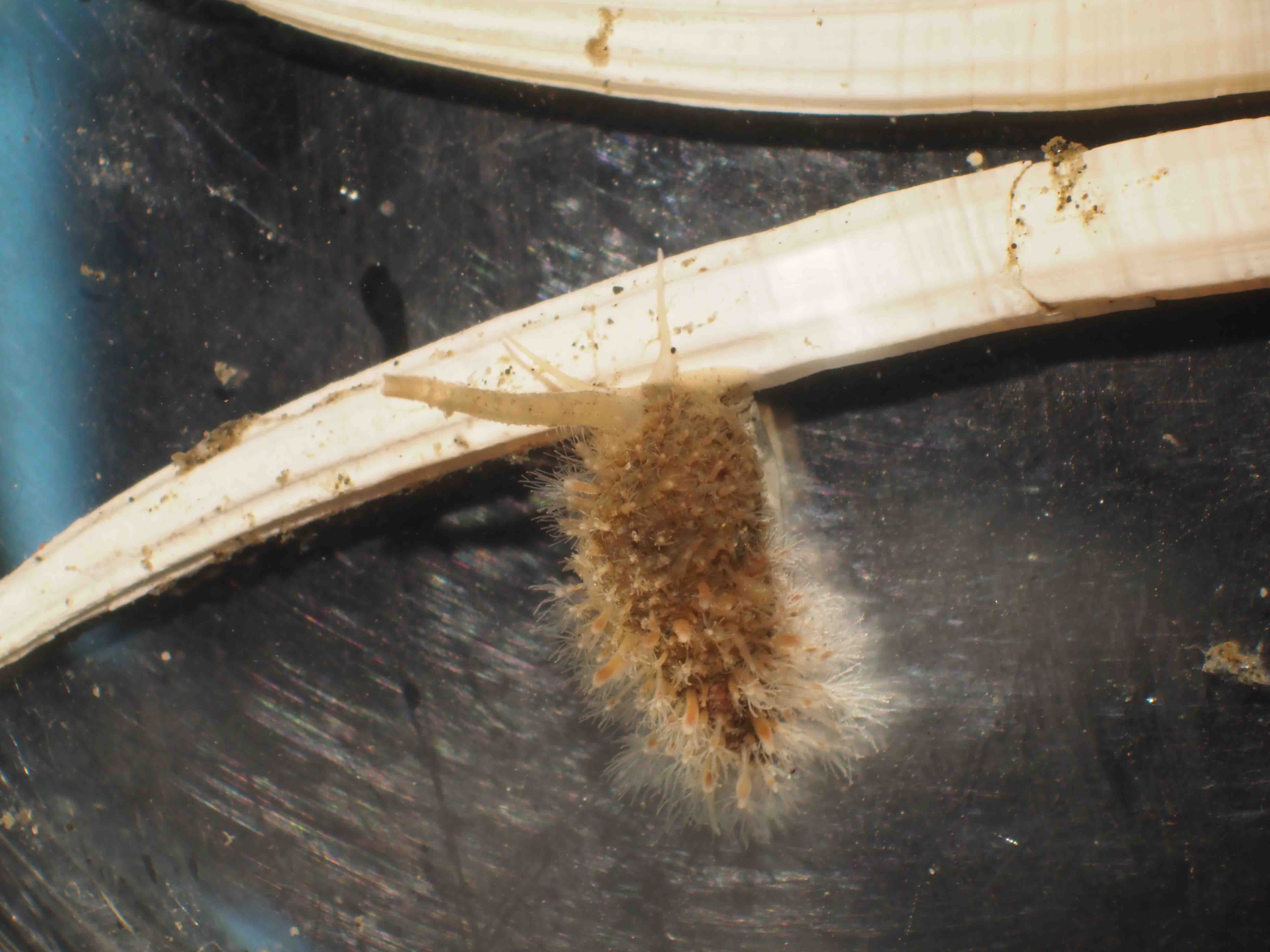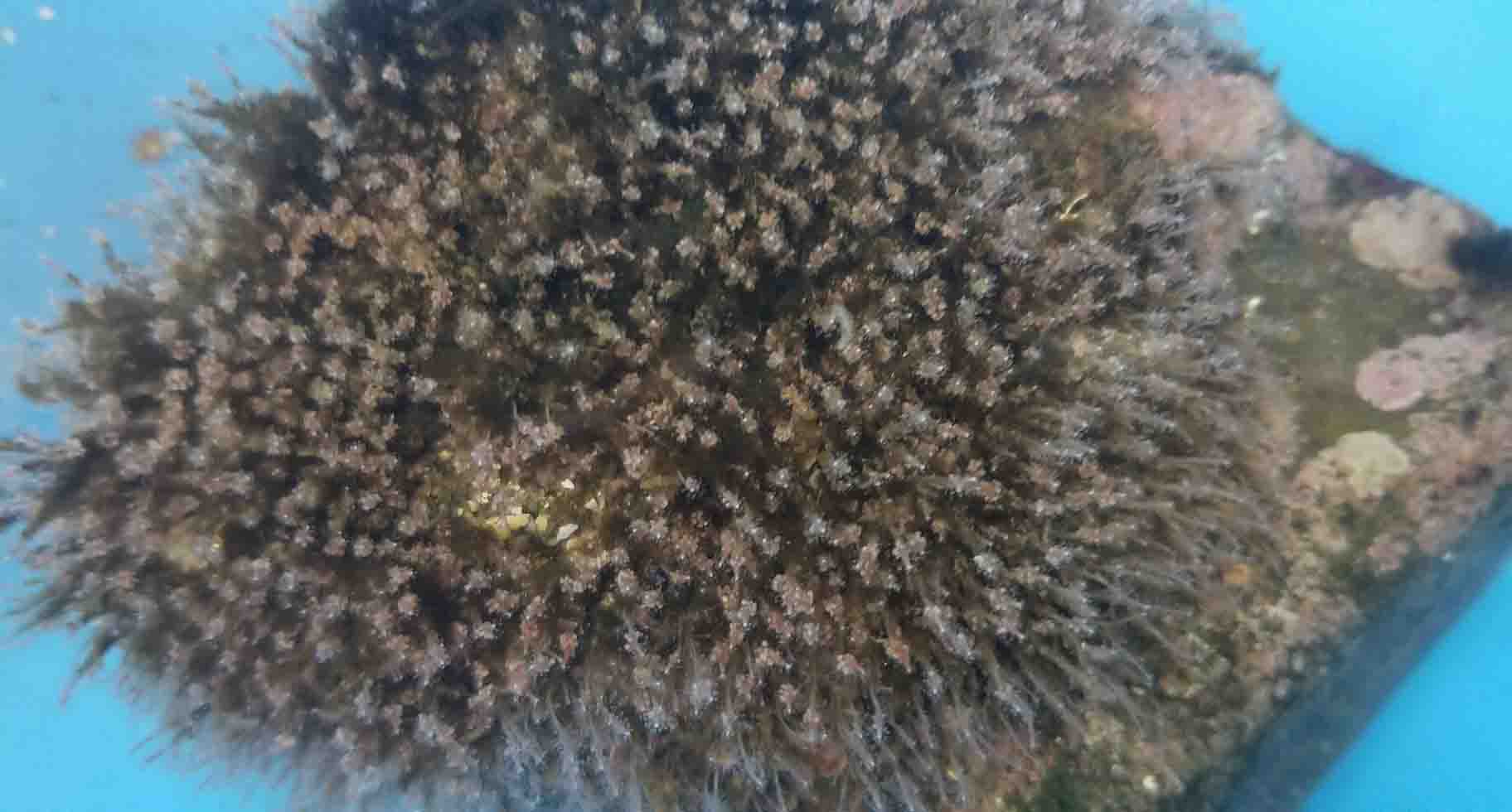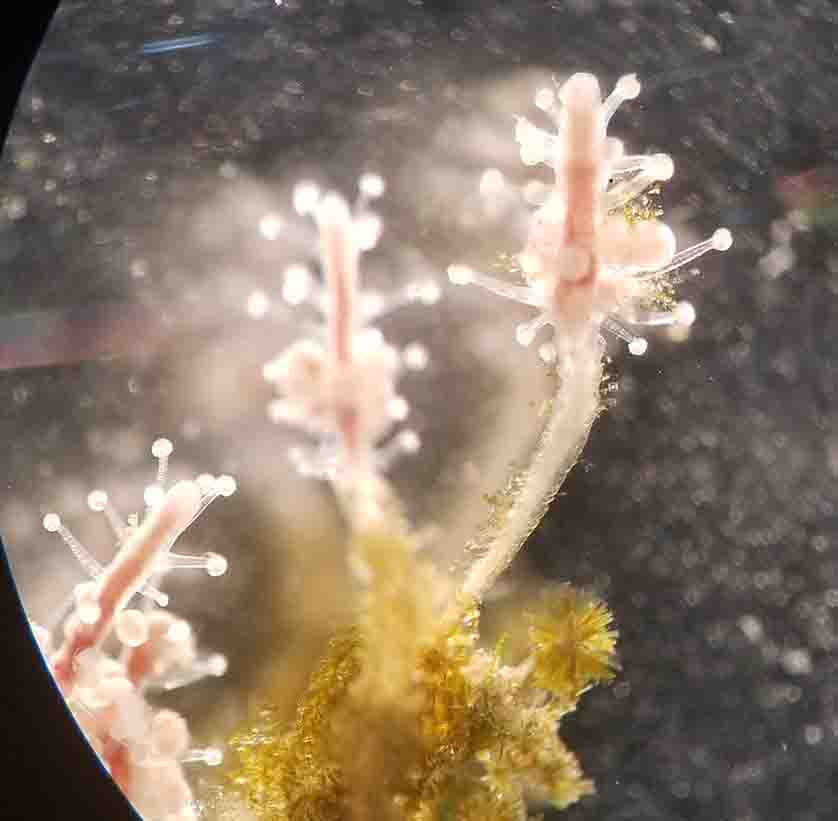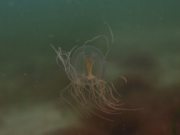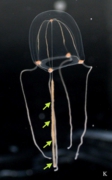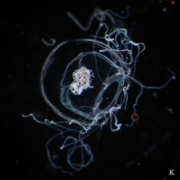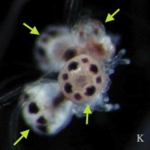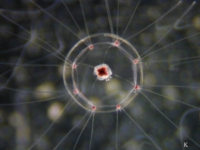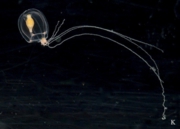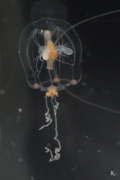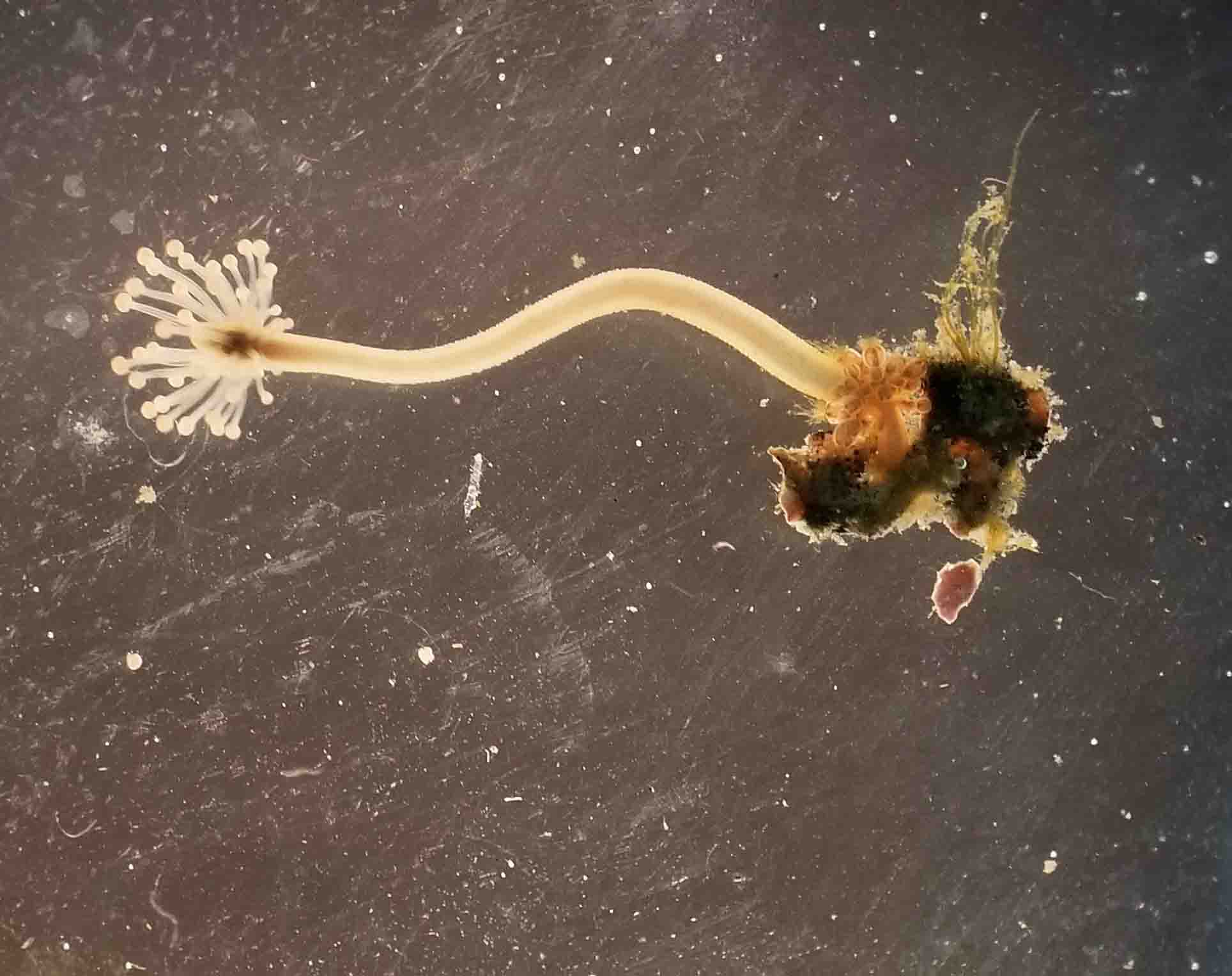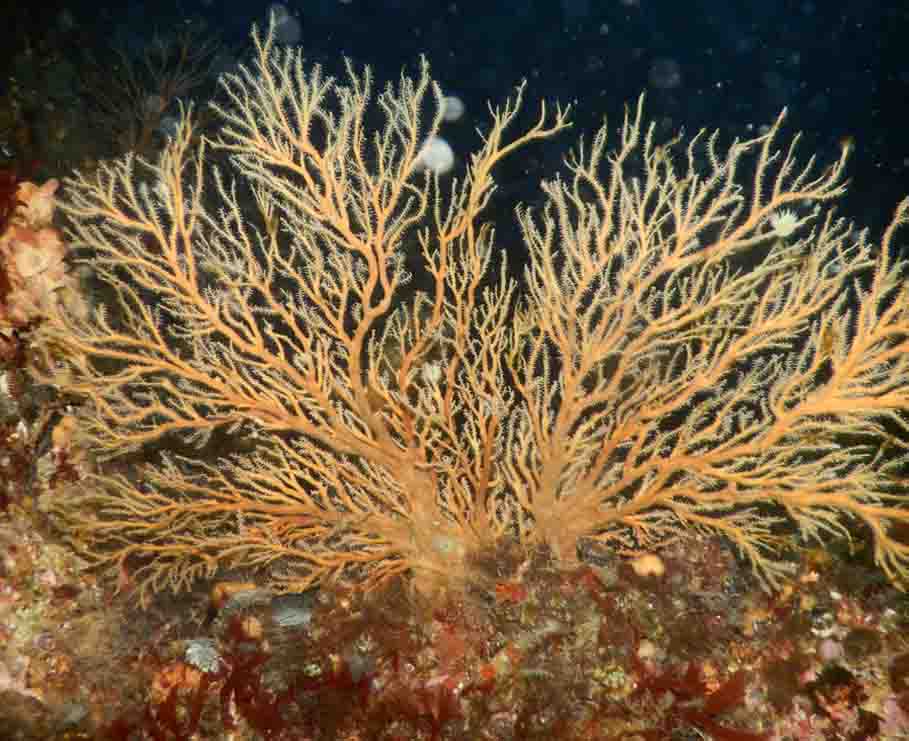ヒドロ虫綱 Hydrozoa
花クラゲ目
-
エダアシクラゲ1
エダアシクラゲ Cladonema pacificum
エダアシクラゲ科
藻場に生息する。センター周辺では6-9月に見られる。かさの高さは8mm程度のクラゲ。ポンポンとバドミントンの羽根ように泳ぐ。 -
エダアシクラゲ2
エダアシクラゲのポリプ。
This species is found from seaweed/grass beds from June to September. The body height is 8 mm and swim with a jumping movement.
-
タマクラゲ 1/3
放卵中。丸いつぶつぶが卵。
Cytaeis uchidae タマクラゲ科
ポリプはムシロガイ上に棲息する。センター付近で採集されるムシロガイにはほぼ100%タマクラゲのポリプが棲息している。生殖シーズンは7月から9月。クラゲは1mm程度と非常に小さい。 -
タマクラゲ 2/3
ポリプが棲息するムシロガイ。
This species’ polyps are found on the shells of Niotha livescens. Almost all individuals of N. livescens are found with this species around Asamushi. The breeding season is July to September. The medusa’s body length is 1 mm. -
タマクラゲ 3/3
タマクラゲのクラゲ。
-
ドフラインクラゲ
Nemopsis dofleini
エダアシクラゲ科 -
ミウラハイクラゲ 1/2
Staurocladia vallentini
エダアシクラゲ科
藻場に棲息する。センター周辺では7-8月に見られる。海藻に付着して棲息している。傘が激しく退化しており、泳ぐことが出来ず海藻の中を這って(歩いて)移動する。触手はエダアシクラゲの触手とよく似る。 -
ミウラハイクラゲ 2/2
This species is found from seaweed/grass beds from July to August. The body is reduced and crawls instead of swimming. The tentacles are similar to that of Cladonema pacificum.
-
ミサキアミネウミヒドラ 1/2
Stylactaria misakiensis
ウミヒドラ科
ムシロガイ類の殻上に棲息している。センター周辺では6-9月に見られる。生殖シーズンは夏期。 -
ミサキアミネウミヒドラ 2/2
This species is found on the shells of Reticunassa. It is found through June to September and breed in the summer.
-
Stylactaria multigranosi 1/2
ウミヒドラ科
ムシロガイ類の殻上に棲息している。センター周辺では6-9月に見られる。生殖シーズンは夏期。センター周辺ではメス個体しか見つかっていない。ミサキアミネヒドラとよく似ておりクラゲが出来るまで区別がつきにくいが、ミサキアミネヒドラよりポリプが小さく、触手も少ない。 -
Stylactaria multigranosi 2/2
生殖シーズンになるとクラゲが目立つ。
This species is found on the shells of Niotha livescens. It is found through June to September and breed in the summer. Only female individuals have been found around our center. This species is very similar to Stylactaria misakiensis and difficult distinguish until the medusa is formed but the polyps are smaller. -
タマウミヒドラ
Coryne pusilla Gaertner, 1774
群体は高さ約3 cm. 数百の個虫からなる群体を形成する. 浅虫では潮間帯の岩上に見られる. -
タマウミヒドラ
Coryne pusilla Gaertner, 1774
Colonies height ca. 3 cm. It forms a colony consisting of several hundred zooids. In Asamushi, it is found on rocky intertidal zones. -
カミクラゲ 1/4
Spirocodon saltator
キタカミクラゲ科名前は触手が髪のようであることに由来する。センターでは春から夏にかけて見られる。比較的大型なクラゲで、傘の高さは10センチほど。 -
カミクラゲ 2/4
This species is found from spring to summer around our center. The body height is 10 cm.
-
カミクラゲ 3/4
-
カミクラゲ 4/4
-
ユウシデクラゲ
Catablema multicirratum Kishinouye, 1910
エボシクラゲ科. 体長 4 cm程度. 傘はベル型で, 多数の触手を持つ. 青森以北に生息する北方系種.
Pandeidae. ca. 4 cm. The umbrella is bell-shared with numerous tentacles. Boreal species found north of Aomori area. -
サルシアクラゲ
Sarsia tubulosa
タマウミヒドラ科
センターでは冬の終わりから春にかけて見られる。傘の高さは1cm程度。口柄(胃)が傘からはみ出しているため、卵や精子が傷つかないかと心配になる。
矢印は、サルシアクラゲの口柄。傘からはみ出している。 -
サルシアクラゲ
This species is found from the end of winter to spring around our center. The body height is 1 cm. The manubrium hangs outside the body (unbrella).
-
シミコクラゲ 1/4
Rathkea octopunctata
シミコクラゲ科
このクラゲは口柄で無性的にクラゲ芽を作る時期と、有性生殖を行うため卵母細胞を作る時期がある。センター周辺では2月から4月に見られる。
口柄にクラゲ芽をつけているクラゲ(無性生殖個体) -
シミコクラゲ 2/4
This species has an asexual period budding from the manubrium and a sexual period generating oocytes. It is found through February to April around our center.
[This photo shows the asexual period] -
シミコクラゲ 3/4
矢印は個々のクラゲ芽(成長したらクラゲになる)
Yellow arrows indicate buds. -
シミコクラゲ 4/4
口柄に卵母細胞を持つクラゲ(有性生殖に切り替わった個体 )
[This photo shows the sexually reproducing period with oocytes] -
ヒトツアシクラゲ1
Hybocodon prolifer
クダウミヒドラ科 -
ヒトツアシクラゲ2
-
オオタマウミヒドラ
Hydrocoryne miurensis Stechow, 1908
ヒドロ茎は長く、先端に円錐形の口丘と20–60本程度の触手をもつ. 数個~数十個の群体として岩石上に付着する. ヒドロ茎下部にある生殖体は成熟するとクラゲを遊離する. 浅虫では潮間帯下部で見られる. -
オオタマウミヒドラ
Hydrocoryne miurensis Stechow, 1908
Hydrocalus is elongated, with a conical hypostome at the tip and around 20-60 tentacles. It attaches to rocks in colonies ranging from a few to several dozen. The gonophores at the base of hydrocalus release jellyfish when mature. It is found in the lower intertidal zone in Asamushi. -
センナリウミヒドラ
Solanderia misakinensis (Inaba, 1892)
ヤギモドキウミヒドラ科. 群体は背が高く、淡褐色. 水深10 m付近.
Solanderiidae. Colony is large and light brown. This species are recorded at 10 m depth.
軟クラゲ目
-
シロガヤ
Aglaophenia whiteleggei
ハネガヤ科
岩に付着して生息する。刺されると痛い。
This species is found on rocks. Harmful. -
オワンクラゲ 1/3
Aequorea coerulescens
オワンクラゲ科
ヒドロ虫綱の中では最大サイズのクラゲで、傘径は20センチほど。GFP(Green Fluorescent Protein)が発見・精製されたクラゲ。暗い場所で傘の縁を刺激すると、緑蛍光色に発光する。センター周辺では春から夏にかけて見られる。 -
オワンクラゲ 2/3
One of the largest Hydrozoa species. GFP (Green Fluorescent Protein) was discovered and extracted from this species. When the body is stimulated in the dark, green florescence is recognised. It is found through spring to summer around our center.
-
オワンクラゲ 3/3
オワンクラゲの捕食の様子。クラゲを食べる。
It is preying on another species of jellyfish. -
Clytiaの1種 1/2
遊離したてのClytia sp. のクラゲ
ウミサカヅキガヤ科
ポリプは流藻上に見られる。センタ周辺では秋頃に見られる。 -
Clytiaの1種 2/2
Clytia sp. のポリプ
This species’ polyps are found on seaweed/grass. It is found in autumn around our center. -
Obelia sp.
ウミサカヅキガヤ科
2mm程度の小さなクラゲ。センター周辺では、3種類は存在する。春、秋、冬に見られる。
2 mm in size. Three species are found around our center. -
カミクロメクラゲ
Tiaropsis multicirrata
淡水クラゲ目
-
カギノテクラゲ 1/2
Gonionema vertens
淡水クラゲ目ハナガサクラゲ科
名前は触手の先が鉤(フック)のように折れ曲がっていることに由来する。藻場(海藻・海草)に棲息しており、センター周辺では夏に見られる。刺されると「痛い」ため、海水浴場などで大量発生すると入水禁止になる。 -
カギノテクラゲ 2/2
This species is found from seaweed/grass beds in the summer. Harmful.
管クラゲ目
-
ケムシクラゲ
Apolemia uvaria (Lesueur, 1811)
クダクラゲ目ケムシクラゲ科. ヒモ状で長い群体を作る.
Siphonophorae. Apolemiidae. The colony forms long threads floating in the ocean. -
クダクラゲ目の1種
Siphonophorae
多数の個体がつながって漂うクラゲの1種








